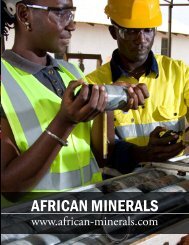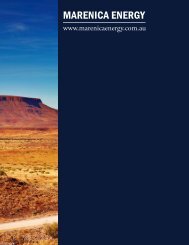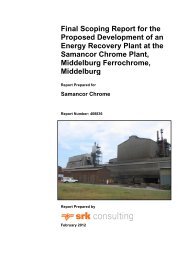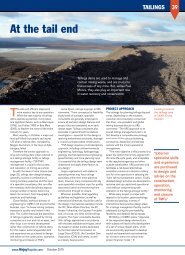Draft Status Quo Report for the Pixley Ka Seme ... - SRK Consulting
Draft Status Quo Report for the Pixley Ka Seme ... - SRK Consulting
Draft Status Quo Report for the Pixley Ka Seme ... - SRK Consulting
Create successful ePaper yourself
Turn your PDF publications into a flip-book with our unique Google optimized e-Paper software.
<strong>SRK</strong> <strong>Consulting</strong> in association with BKS<br />
<strong>Pixley</strong> <strong>Ka</strong> <strong>Seme</strong> Local Municipality EMF – <strong>Draft</strong> <strong>Status</strong> <strong>Quo</strong> <strong>Report</strong> Page 26<br />
Map 14 (after GRAII: Department of Water Affairs and<br />
Forestry (DWAF), 2005) and Vegter, 1995) represents<br />
<strong>the</strong> regional hydrogeology, which comprises:<br />
• The Estcourt Formation (<strong>Ka</strong>roo Supergroup),<br />
extending from <strong>the</strong> south western to <strong>the</strong> western<br />
boundary of PKSLM (including <strong>the</strong> towns of<br />
Perdekop and Volksrust). This is characterised by<br />
arenaceous rocks made of mudstone subordinate<br />
sandstone and is locally intruded by dolerite dykes<br />
and sills. Yields vary from 0.5-2 L/s with a<br />
generally lower occurrence (0.0-0.1 L/s) in <strong>the</strong> area<br />
of Volksrust;<br />
• The Volksrust Formation (<strong>Ka</strong>roo Supergroup)<br />
underlying <strong>the</strong> centre of PKSLM consists of<br />
mudstones and shale subordinate silstones. Dolerite<br />
sills and dykes intrude <strong>the</strong> area. Yields vary from<br />
0.1 to 0.5 L/s increasing in <strong>the</strong> sou<strong>the</strong>rn area to<br />
between 0.5 – 2.0 L/s; and<br />
• The Vryheid Formation mainly on <strong>the</strong> eastern side<br />
of <strong>the</strong> PKSLM and comprises sandstone, shale with<br />
coal seams and intrusions of dolerite dykes and<br />
sills. Those rocks are characterised by massive, low<br />
porosity rocks with a few widely spaced joints and<br />
<strong>the</strong> yields vary between 0.5-2.0 L/s. The sandstone<br />
has very little storage capacity <strong>for</strong> water and<br />
transmits water slowly, mostly through fractures<br />
and faults.<br />
Groundwater recharge<br />
mbgl, and increases from west to east across <strong>the</strong> study<br />
area. Surface water and groundwater interaction occurs<br />
along <strong>the</strong> river and stream courses, where groundwater<br />
levels are likely to be not more than a few meters below<br />
surface.<br />
Fountains (springs or seeps) have been mapped<br />
(regionally) along <strong>the</strong> contacts of <strong>the</strong> <strong>Ka</strong>roo Vryheid<br />
Formation sediments and intrusive dolerite sills.<br />
Aquifer classification<br />
The aquifer is classified as a minor aquifer on a regional<br />
scale. The aquifer is nei<strong>the</strong>r classified as a sole source<br />
aquifer nor a special aquifer (South African Aquifer<br />
System Management Classification of South Africa, R.<br />
Parsons, 1995).<br />
Groundwater supply and use<br />
At a provincial scale, 65% of water resources available<br />
in Mpumalanga come from surface water resources.<br />
Water transfers into <strong>the</strong> Province provide 19% of total<br />
water availability, while groundwater accounts <strong>for</strong> 6%<br />
of available water (Mpumalanga State of Environment<br />
<strong>Report</strong> (SOER), 2003).<br />
Data <strong>for</strong> groundwater supply and use are limited and<br />
according to DWA WARMs database, <strong>the</strong>re is one<br />
registered water supply borehole located in <strong>the</strong> nor<strong>the</strong>rn<br />
part of <strong>the</strong> PKSLM, with a yield of 0.041 million m 3 /a.<br />
No o<strong>the</strong>r boreholes were listed and it is <strong>the</strong>re<strong>for</strong>e<br />
difficult to determine <strong>the</strong> current groundwater use.<br />
The upper wea<strong>the</strong>red aquifer is recharged by rainfall<br />
with <strong>the</strong> annual groundwater recharge expected to be in<br />
<strong>the</strong> order of 22 to 180 mm/a (GRAII, 2006), and<br />
increases from west to east across PKSLM. The mean<br />
annual groundwater recharge is presented, after Vegter<br />
(1995) and GRAII (2006), in Map 8.<br />
The recharge rate in wea<strong>the</strong>red sediments could be<br />
highly variable depending on <strong>the</strong> hydraulic conductivity<br />
of <strong>the</strong> overlying soils (clays would <strong>for</strong> example limit <strong>the</strong><br />
ingress of rainwater) and variable surface topography.<br />
Groundwater flow<br />
Groundwater levels would be expected to mimic<br />
surface topography in <strong>the</strong> catchment due <strong>the</strong> semiconfined<br />
nature of <strong>the</strong> aquifers. According to <strong>the</strong> GRAII<br />
database, <strong>the</strong> depth to groundwater ranges between 6-16<br />
The groundwater potential of <strong>the</strong> <strong>Ka</strong>roo <strong>for</strong>mations<br />
located in <strong>the</strong> study area is limited in <strong>the</strong>ir pristine state<br />
due to low permeability and storage capacity.<br />
Secondary processes, alteration due to contact<br />
metamorphism with <strong>the</strong> intrusive dolerite, are<br />
recognised to enhance <strong>the</strong> groundwater potential of<br />
<strong>the</strong>se lithological units. Minor faults are localised in <strong>the</strong><br />
sou<strong>the</strong>rn area and may increase <strong>the</strong> groundwater<br />
occurrence.<br />
The annual groundwater recharge is expected to be of<br />
<strong>the</strong> order of 22 to > 180 mm/a, and increases from west<br />
to east across PKSLM (Vegter, 1995 and GRAII, 2005).<br />
Groundwater levels would be expected to mimic<br />
surface topography in <strong>the</strong> catchment due <strong>the</strong> semiconfined<br />
nature of <strong>the</strong> aquifers. According to <strong>the</strong> GRAII<br />
database (DWAF, 2005), <strong>the</strong> depth to groundwater<br />
KILI/BEAT G:\404946_PIXLEY EMF\7REPORTS\<strong>Status</strong> <strong>Quo</strong> report\<strong>Draft</strong> report\<strong>Draft</strong> status quo report, July 2010.docx July 2010









